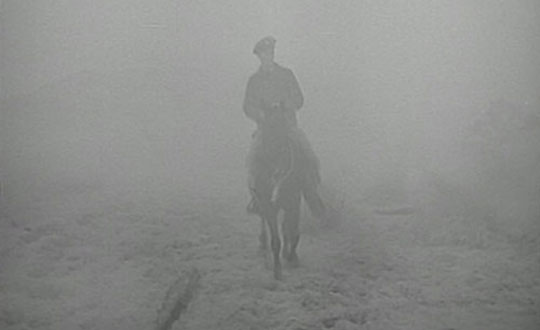
NOTES ON FILM & RESTORATION
10/28/2021It’s been a while since I’ve seen Jean Renoir’s The Woman on the Beach, but it’s a film that’s never left me, and I was excited to know that The Film Foundation had collaborated on a restoration with the Library of Congress, funded by the Hobson/Lucas Family Foundation. I remember it discontinuously, in powerful, resonant fragments. “The Woman on the Beach was a perfect theme for treating the drama of isolation,” wrote Renoir in his autobiography. “Its simplicity made all kinds of development possible.” The story, adapted from a novel called None So Blind, is a kind of spiraling dance of death between two men and the woman they both love: a famous painter (Charles Bickford) who has lost his sight in an accident caused by his young wife (Joan Bennett), who seeks the company of a traumatized WWII vet (Robert Ryan) when he crosses her path patrolling a desolate stretch of beach for the Coast Guard. Renoir noted that with his last American film, he had moved away from any ambition to depict “the bonds uniting the individual to his environment,” a constant in his work before and after. “I was embarked on a study of persons whose sole idea was to close the door on that absolutely concrete phenomenon we call life.” The production of the film, recounted in detail by the great film scholar Janet Bergstrom in a 1999 article for Film History, is far more complex than the narrative of the finished film. RKO purchased the rights to the story in serialized form and gave notes to the author, Mitchell Wilson, before it was published as a novel. A script was written and Bennett, set to star, insisted on Renoir as a director, over the strenuous objections of the assigned producer, Val Lewton, who moved on from RKO before production began. During the shoot, the script was constantly amended, partly to address objections from the Production Code Administration. There was a disastrous August 1946 preview in Santa Barbara, followed by series of new edits that were screened for, among other people, Mark Robson and John Huston, who gave their input. Renoir went to work with a different writer, Frank Davis (both men were good friends of the independent producer and director Albert Lewin) and reworked and/or re-shot somewhere between one third and one half of the film. The Woman on the Beach was finally delivered in April 1947. “Renoir managed to maintain a consistent perspective despite everything,” writes Bergstrom, “a consistency that came from paring down the elements of the film in almost Langian style by the time it was finished.” What exactly does “Langian” mean? That Renoir’s solution to dealing with the multiple limitations imposed on him by the enforcers of the Code and all the “Helpful Creative Suggestions” he undoubtedly had to endure from RKO execs was to remove secondary characters and explanatory scenes, to pull out dialogue, and to make the film more and more abstract. Which is undoubtedly why certain images and scenes have not just lingered but expanded in my memory—Ryan’s nightmare of jumping from his destroyed ship, falling to the bottom of the sea and into the arms of his beloved…Ryan riding on horseback through the fog and discovering Bennett by a shipwreck… and the remarkable moment where Bennett and Bickford sit next to each other, by the fireplace, both looking off in different directions, drily ruminating on their wreck of a marriage. It’s a very special film, quite unlike anything else by Renoir, and finally quite unlike anything else, period.
- Kent Jones
Follow us on Instagram, and Twitter!
THE WOMAN ON THE BEACH (1947, d. Jean Renoir)
Restored by the Library of Congress and The Film Foundation. Funding provided by the Hobson/Lucas Family Foundation.
